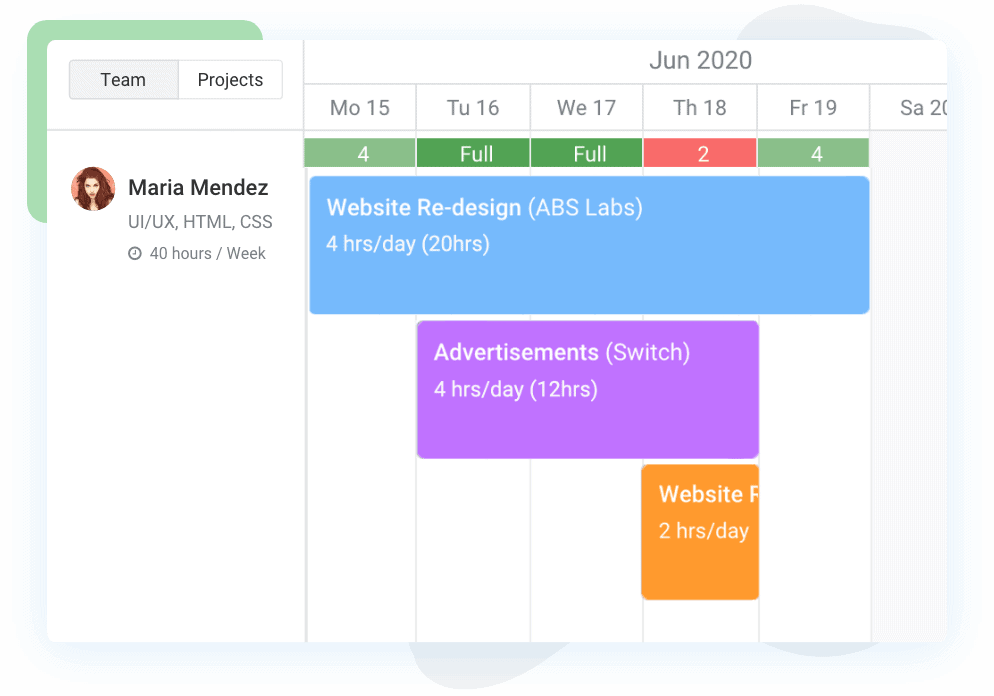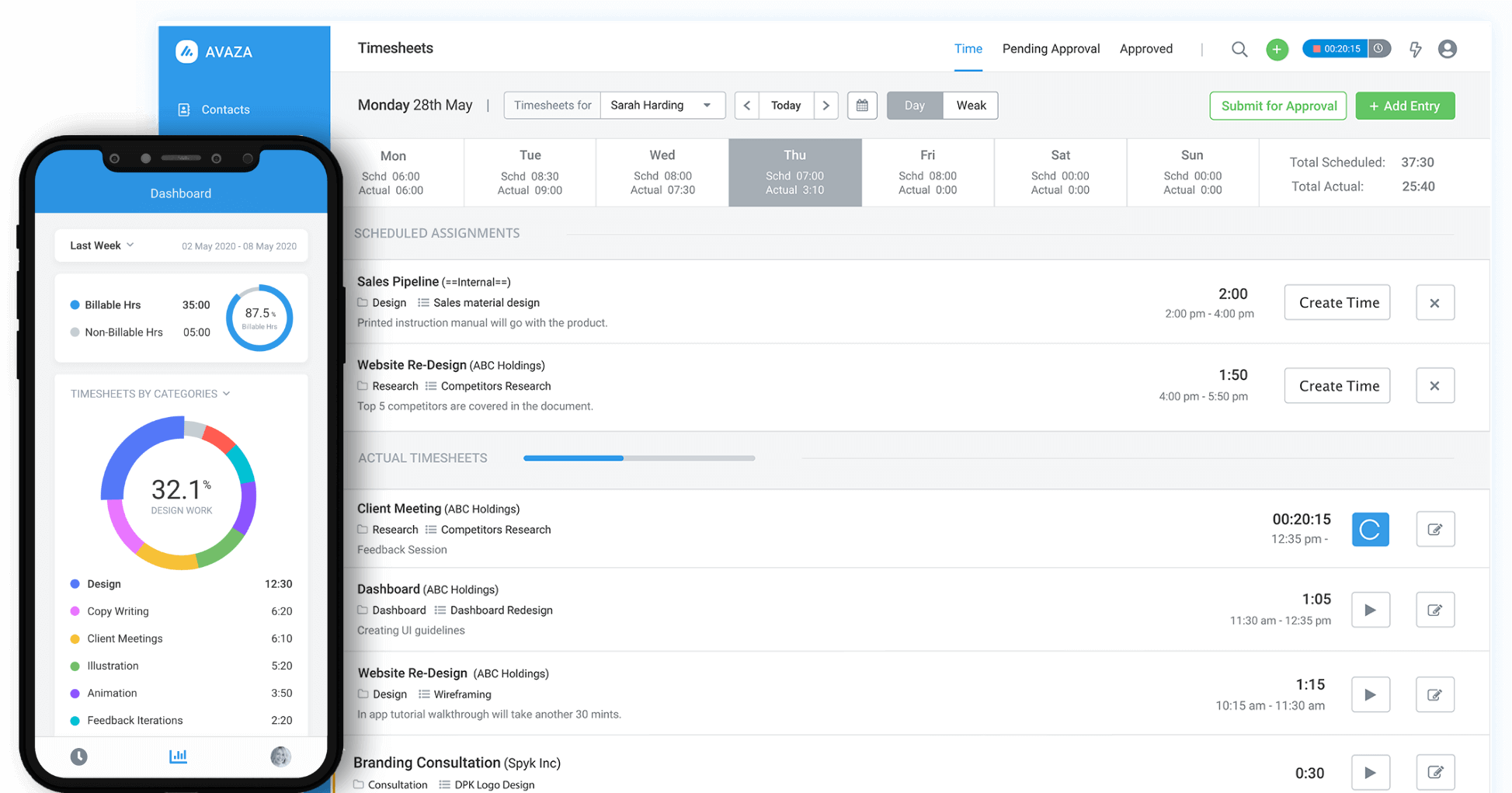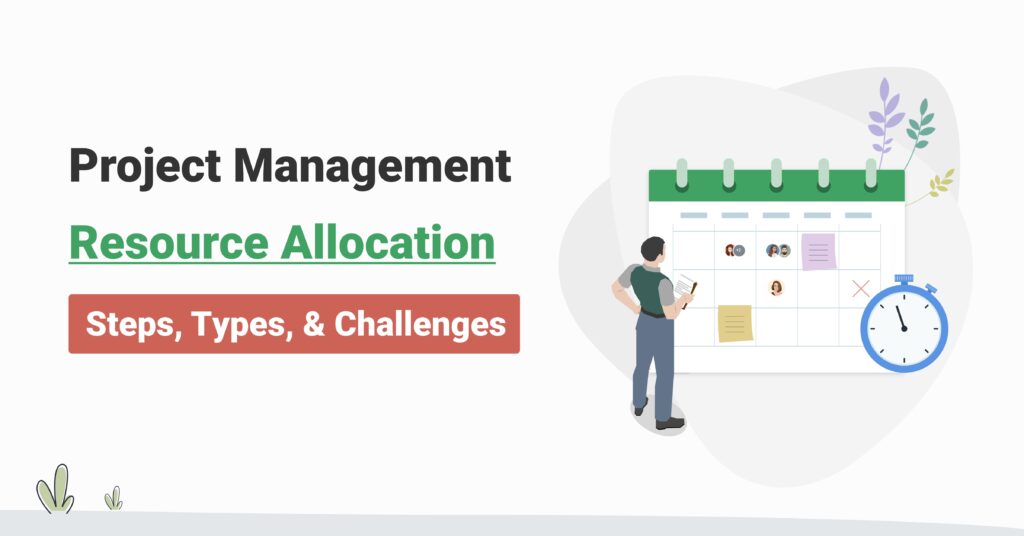Table of Contents
Project Management Resource Allocation | Steps, Types, & Challenges
Resource allocation is a required process in project management involving effectively distributing a company’s assets to achieve project goals. At its core, resource allocation ensures that every project has the necessary support—be it people, time, or materials—to succeed.
Deploying the appropriate resources at precisely the right juncture directly influences operational efficiency. Strategic resource management facilitates cost containment by reducing resource wastage and decreasing latency, thereby enhancing project timelines and overall productivity.
It also supports timely delivery by aligning resources with project schedules and objectives.
This article explores essential aspects of project management resource allocation. It begins by defining resource allocation, then, we’ll cover the various types of resources involved in this process and discuss why effective allocation is necessary for project success.
What is Resource Allocation in Project Management?
A resource is anything that helps you complete a project. This includes several things like:
👥 Team members
💰 Budget
⏳ Project timelines
💡 Ideas
📜 Intellectual property
🎯 Specific skill sets
🛠️ Equipment
🔧 Tools
Even automated processes that reduce repetitive work are considered resources.
Now, let’s discuss what resource allocation is.
Resource allocation is the practice of assigning and scheduling available resources in the most productive and economical way possible. It involves identifying the right resources needed to accomplish project deliverables and strategically distributing them to maximize efficiency and impact.
Resource allocation in project management ensures resources are used efficiently, minimizing costs and avoiding delays. It plays a vital role in coordinating resources with the project schedule.
This helps project managers determine who does what. It also specifies when tasks should be completed and outlines the necessary tools or support.
Most Common Types Of Project Management Resources To Allocate
Resource allocation is a fundamental aspect of project management, involving the distribution of various primary types of resources.
These resources are critical to consider regardless of the industry or project scope.
Types | Descriptions |
Human Resources | Human resources include team members, stakeholders, and contractors. Effective management involves selecting skilled individuals, managing workloads, and providing necessary support to ensure project success. |
Time Resources | Time resources refer to the duration needed to complete the project. Proper management involves setting realistic deadlines, monitoring progress, and adjusting the schedule to avoid delays. |
Financial Resources | Financial resources cover the budget for labor, materials, and overhead costs. Create and track the budget to prevent overspending and ensure you use funds efficiently. |
Material Resources | Material resources are the physical items needed, such as supplies and materials. It involves procuring, tracking, and using these materials efficiently to avoid shortages or excesses. |
Equipment Resources | Equipment resources include tools and machinery like computers and software. Managing these resources involves selecting the right equipment, maintaining it, and ensuring its practical use. |
Information Resources | Information resources include data, research, and documentation. This ensures that information is accurate, up-to-date, and accessible to stakeholders for informed decision-making. |
Space Resources | Space resources involve the physical areas needed, such as office or storage space. Ensure these spaces are well-organized and used efficiently to support project activities. |
Common Steps for Allocating Resources in Any Project
Following are the essential steps for effective resource planning & allocation to streamline your project management and drive success.
1. Assess Resource Requirements
Start by clearly understanding your project’s goals and tasks. Identify what’s required to complete each task, including team members, skills, equipment, and budget. Determine the necessary types and amounts of resources, focusing on human and material needs.
For example, if a task requires specialized skills or expensive equipment, ensure you’ve accurately assessed these requirements. Evaluating your resource needs from the outset helps prevent last-minute scrambling and sets a solid foundation for project success.
2. Prioritize Resource Requirements
Once you know what resources you need, prioritize them based on their value in the project’s success. Some resources—like key team members or essential equipment—will be critical, so you can’t proceed without them.
Others, such as additional software or personnel, may be beneficial but not essential.
Rank resources according to their impact on project milestones and deadlines. This prioritization aids in making informed decisions and managing trade-offs effectively, ensuring that the most critical needs are met first.
3. Strategically Allocate Resources for the Project
Distribute your resources thoughtfully to match the needs identified. Allocate the most skilled team members to complex tasks and ensure essential equipment is available when required.
Balance resource distribution to avoid overloading one area while neglecting another.
This strategic allocation helps prevent bottlenecks and delays. The goal is to optimize resource use across all project phases. Each phase should have what it needs to proceed smoothly without overextending your resources.
4. Monitor and Adjust Resources Throughout the Project
Resource allocation is not a one-time task. Continuously monitor how you use resources and make adjustments as needed. For example, track whether team members are overburdened or underutilized and check if they use equipment efficiently.
Address any imbalances promptly to avoid issues like budget overruns or delays. Regular adjustments keep the project aligned with its evolving needs. It helps maintain the project’s progress and mitigate potential problems that might arise.
5. Evaluate and Optimize Your Resource Allocation Process
After project completion:
- Review your resource allocation process.
- Analyze what went well and identify areas needing improvement.
- Reflect on whether resources were allocated effectively or if adjustments could have enhanced project outcomes.
This evaluation should focus on both successes and shortcomings, offering insights for future projects. Recognizing effective project management strategies and learning from challenges helps refine your approach and improve resource allocation practices over time.
Using a Project Management Software for Resource Allocation | Avaza
Avaza simplifies project management resource allocation by offering a comprehensive, all-in-one platform that eliminates the need to juggle multiple tools.
With Avaza, you can instantly view team availability and allocate resources efficiently with a clear perspective. See who’s working on what and easily track what’s being done and when. This allows you to make intelligent scheduling decisions with just a simple drag and drop.
Let’s delve into Avaza’s features that make resource allocation a breeze for project managers.
1. Project Management

Avaza allows you to quickly create and manage projects by defining the scope, setting deadlines, and allocating budgets. Resources can be assigned based on the project’s needs from the start. It helps avoid all sorts of misallocation and ensures smooth progress.
Task Management is seamless with Avaza, enabling you to define and assign tasks with clear deadlines and priorities. You can manage recurring tasks, set dependencies, and ensure every task flows logically from one to the next, eliminating bottlenecks.
Team Collaboration is enhanced through integrated communication tools. Avaza’s team chat allows for real-time discussions, while file attachments and comments keep all relevant information within easy reach.
By centralizing communications, Avaza promotes a collaborative environment where teams stay informed and engaged throughout the project lifecycle.
Progress Tracking becomes intuitive with Avaza’s visual tools like Gantt charts and Kanban boards. These tools give you a comprehensive view of task progress, making it easier to identify roadblocks and adjust schedules as needed.
Real-time updates keep the entire team in sync, ensuring that projects stay on track and meet their deadlines.
2. Resource Allocation

Avaza’s resource scheduling feature enables efficient management by visualizing team assignments and project portfolios on a single screen.
It offers easy schedule creation and adjustment through drag-and-drop, improving team utilization and ensuring optimal resource allocation. The color-coded interface and availability bar enhance decision-making and project efficiency.
Avaza enhances capacity planning by helping you avoid overloading or underutilizing your resources. By assessing individual availability and project requirements, you can create balanced schedules that optimize team productivity.
3. Time Tracking

Avaza’s online timesheets let you precisely monitor hours spent on tasks and projects. This aids in understanding labor costs and project profitability.
By recording detailed time entries, you can evaluate how resources are utilized and adjust allocations as needed.
To maintain accuracy and control, Avaza includes a timesheet approval process. This allows managers to review and approve all logged hours, ensuring that each entry is correct and authorized.
By integrating these capabilities, Avaza helps streamline resource allocation and align it with your project goals and budget.
4. Expense Management

Avaza’s powerful expense management features track and categorize expenses from anywhere, ensuring no receipt goes unnoticed.
You can easily create and track expenses, linking them directly to specific projects and tasks. This provides clear visibility into project budget utilization, allowing for effective monitoring and control over project spending.
The software also forwards receipts via email for automatic entry and manages approval workflows with clear, actionable notifications. It simplifies reimbursements and integrates project expenses seamlessly into client invoices. With Avaza, you can easily keep your project budgets under control and optimize spending.
Avaza’s strong approval workflows further refine expense management. Automated notifications keep all stakeholders informed during the approval stages, ensuring everyone is up-to-date. Once expenses are approved, they are locked, ensuring safety against unauthorized changes.
5. Invoicing and Financial Management
Avaza’s customizable invoicing features allow you to create branded invoices custom-made to each client’s needs. This ensures accurate billing and streamlined financial operations.
Automate recurring invoices to maintain a steady cash flow and track payments to avoid missed revenue. It generates invoices based on tracked time and expenses.
The software also streamlines the creation of estimates and quotes. With a single click, you can quickly send professional estimates and convert them into invoices and projects once approved.
Avaza Online User Reviews
As of the writing date, Avaza has 4.6 out of 5 stars and 421 reviews on Capterra.
Here’s what some of Avaza’s users have to say about their product.



Try Avaza For Free
If you feel that Avaza might be the software to measure the profitability for your projects, sign up to start using Avaza for free. If you need any help with your Avaza subscription or want to better understand our pricing, please contact chat support or email support@avaza.com.
What Impacts Resource Allocation In Project Management?
Resource allocation in project management is a continuous and dynamic process, extending throughout the entire project lifecycle. It involves strategically assigning and managing resources to ensure project success.
When executed properly, resource management yields several benefits.
- Improves productivity, helping teams meet goals and milestones on time.
- Ensures team members are well-supported with clear guidelines and adequate tools, promoting a supportive work environment.
- Prevents wastage and maintains financial efficiency.
- Offers a transparent overview of resource distribution, leading to quicker and more informed decision-making.
- Reduces errors and minimizes stress among team members.
Despite its advantages, resource allocation presents challenges.
- Projects often evolve, leading to changes in scope that can disrupt the original resource plan and require frequent adjustments.
- Aligning team members’ skills with project needs can be complex.
- Miscommunication may result in resource mismanagement.
- Tracking and prioritizing tasks based on changing project needs requires constant adaptation.
- Continuous monitoring and flexible reallocation are necessary to keep the project on track.
How To Allocate Resources Properly? Resource Allocation Strategy
An effective resource allocation strategy ensures you have the right resources aligned with your project’s goals and priorities throughout its lifecycle.
Start this process early, ideally during the project planning phase, to avoid last-minute adjustments and ensure smooth project execution.
1. Start With the End in Mind
Clearly define the project’s objectives from the outset. This includes setting specific, attainable goals, determining key deliverables, and establishing milestones and a high-level timeline.
By understanding what you want to achieve, you can allocate resources in a way that aligns with these objectives and ensures that every resource contributes effectively towards the end goal.
2. Identify Available Resources
Assess all available resources for the project, including team members, budget, tools, and equipment (to avoid all types of resource constraints). Determine the project’s priority level to guide resource allocation—higher-priority projects may require more immediate and extensive resources.
Review your team’s current workload and availability. If necessary, adjust existing priorities or reschedule tasks to accommodate the new project. Ensure you have the budget and any additional tools or skills needed.
Confirm the plan with stakeholders responsible for budgets or other key resources to avoid conflicts or gaps.
3. Align on Project Scope
A well-defined project scope is necessary. Understand the project’s goals, deadlines, and deliverables to establish clear boundaries and expectations.
This clarity helps prevent scope creep—where additional requirements expand beyond the initial plan—by keeping the project focused.
Review and adjust the scope regularly as needed to adapt to changes while remaining aligned with the project’s objectives.
4. Create and Share a Project Plan
Once you’ve assessed available resources, share this information with the project team. Organize an initial meeting to present the project plan, milestones, schedule, and any task dependencies.
Use workload management software to track progress, allocate resources, and manage changes. A centralized system provides a single source of truth for resource availability and project status, making it easier to adjust priorities and reallocate resources as needed.
5. Monitor Project Progress
Continuous monitoring is important to keep the project on track. Track team performance, handle any delays, and adjust resource allocation in real-time.
Regular updates help manage unforeseen issues. These include team members taking vacations or changes in client availability. They ensure the project remains on schedule.
Real-time tracking enables quick responses to developments, helping maintain project momentum and success.
What Are the Common Challenges in Resource Allocation?
Effective resource allocation can drive goal achievement, enhance impact, and optimize resource use. While proficiency grows with experience, beginners often face specific challenges.
Here’s a guide to overcoming common pitfalls.
1. Burnout and Over-Allocation
Overwork and burnout are major pitfalls in resource allocation. Team members are at risk of burnout when they’re overloaded with tasks or working excessively long hours. This condition, recognized by the World Health Organization as chronic workplace stress, can seriously affect productivity and morale.
A primary challenge is the insufficient transparency into team members’ workloads, particularly when managing multiple concurrent projects. Without a comprehensive overview of individual task allocations, there is a risk of over-assigning responsibilities, leading to resource exhaustion.
To address this, you should implement continuous workload assessments and employ capacity planning methodologies to ensure equitable task distribution. Leveraging advanced resource management tools and analytics can facilitate optimal workload balancing and mitigate the risk of team burnout.
2. Resource Dependencies
Resource allocation can be disrupted by dependencies and unexpected changes. For example, if a project timeline extends, it can delay your own project’s start.
To mitigate these uncertainties, employ advanced resource management systems and project management software to monitor resources in real-time.
These systems facilitate the real-time detection of resource shortages and project delays, enabling timely adjustments to project plans and schedules.
3. Low Resource Utilization
A significant proportion of knowledge workers, approximately 60%, allocate their time to administrative functions. These include document retrieval, approval workflows, and app navigation. This allocation constrains their availability for strategic and high-value tasks to just 40%.
Optimizing resource utilization transcends merely extending team capacities; it involves honing in on activities with substantial impact.
Prioritizing tasks based on their strategic value enables team members to direct their efforts toward high-impact initiatives.
Why Resource Management Software Is Important For Resource Allocation?
Resource management software helps you use resources better across different projects.
It makes sure resources are assigned correctly by showing you what’s available and what’s needed. This is especially helpful when several projects need the same resources. With a clear view, you can manage resources without problems.
Here are some additional benefits you can expect with the software 👇
Benefit | Description |
Centralized Resource Management | Centralizes all project resources, allowing for efficient allocation, tracking, and resolution of conflicts. |
Increased Efficiency | Automates scheduling, tracking, and reporting, reducing manual effort and streamlining processes. |
Improved Resource Allocation | Ensures resources are assigned to the right tasks and projects at the right times, raising productivity. |
Real-Time Resource Tracking | Provides real-time resource usage monitoring, allowing for swift identification and adjustment of bottlenecks. |
Resource Capacity Planning | Offers tools for planning and allocating resources based on capacity, preventing overuse and underuse. |
Risk Mitigation | Identifies potential resource constraints and conflicts early, reducing the risk of delays and failures. |
Improved Collaboration | Facilitates better communication among team members regarding resource allocation, reducing miscommunication and errors. |
Frequently Asked Questions (FAQs)
Who is responsible for resource allocation in project management?
The project manager handles resource allocation, ensuring resources are efficiently assigned during project planning. They identify and allocate necessary resources before the project starts and may consult resource planners for broader insights into company performance and resource availability.
What is change management in project management?
Change management is a structured approach within project management that focuses on managing modifications to stakeholders, resources, and workflows. It prioritizes adapting processes to meet organizational needs, aiming to minimize disruption and ensure business continuity.
It integrates with project objectives to support smooth transitions and align with evolving requirements.
Conclusion
Proper resource management supports your overall goals. Accurate allocation mitigates resource wastage, reduces latency, and ensures alignment with project deliverables.
Enhancing your resource allocation protocols can significantly refine your project management methodologies, thereby augmenting productivity and overall performance.
Advance your project management capabilities with Avaza’s strong features and transform your operational strategy today!
